library(ggplot2)
library(lattice)
library(lme4)
Loading required package: Matrix
library(lmerTest)
Attaching package: 'lmerTest'
The following object is masked from 'package:lme4':
lmer
The following object is masked from 'package:stats':
step
library(readr)
library(tidyr)
Attaching package: 'tidyr'
The following objects are masked from 'package:Matrix':
expand, pack, unpack
library(dplyr)
Attaching package: 'dplyr'
The following objects are masked from 'package:stats':
filter, lag
The following objects are masked from 'package:base':
intersect, setdiff, setequal, union
Data exploration
- Load the pitch and politeness data.
politeness_data <- read_csv(file.path("..", "..", "data", "politeness_data.csv"))
Parsed with column specification:
cols(
subject = col_character(),
gender = col_character(),
scenario = col_double(),
attitude = col_character(),
total_duration = col_double(),
frequency = col_double()
)
- Examine the data. Some questions you should be able to answer after examining the data are:
- How many individuals are in the study?
- How many conditions?
- How many observations did each individual contribute per condition?
politeness_data
# A tibble: 80 x 6
subject gender scenario attitude total_duration frequency
<chr> <chr> <dbl> <chr> <dbl> <dbl>
1 F1 F 1 pol 18.4 215.
2 F1 F 1 inf 13.6 211.
3 F1 F 2 pol 5.22 285.
4 F1 F 2 inf 4.25 266.
5 F1 F 3 pol 6.79 211.
6 F1 F 3 inf 4.13 286.
7 F1 F 4 pol 6.24 252.
8 F1 F 4 inf 3.24 282.
9 F1 F 5 pol 5.62 230.
10 F1 F 5 inf 3.95 250.
# ... with 70 more rows
# Use 'View()' when examining data interactively
# View(politeness_data)
table(politeness_data$subject)
F1 F3 F7 F8 M1 M3 M5 M7
10 10 10 10 10 10 10 10
table(politeness_data$subject, politeness_data$attitude)
inf pol
F1 5 5
F3 5 5
F7 5 5
F8 5 5
M1 5 5
M3 5 5
M5 5 5
M7 5 5
- Create a scatterplot of pitch in the informal and polite conditions. Colour points by the speaker’s gender and add a regression line.
- Hint: Use
geom_smooth(method="lm")to add regression lines to your scatter plot.
- Hint: Use
politeness_wide <- politeness_data %>% select(-total_duration) %>% spread(key=attitude, value=frequency)
ggplot(politeness_wide, aes(x=inf, y=pol, colour=gender)) + geom_point() + geom_smooth(method="lm")
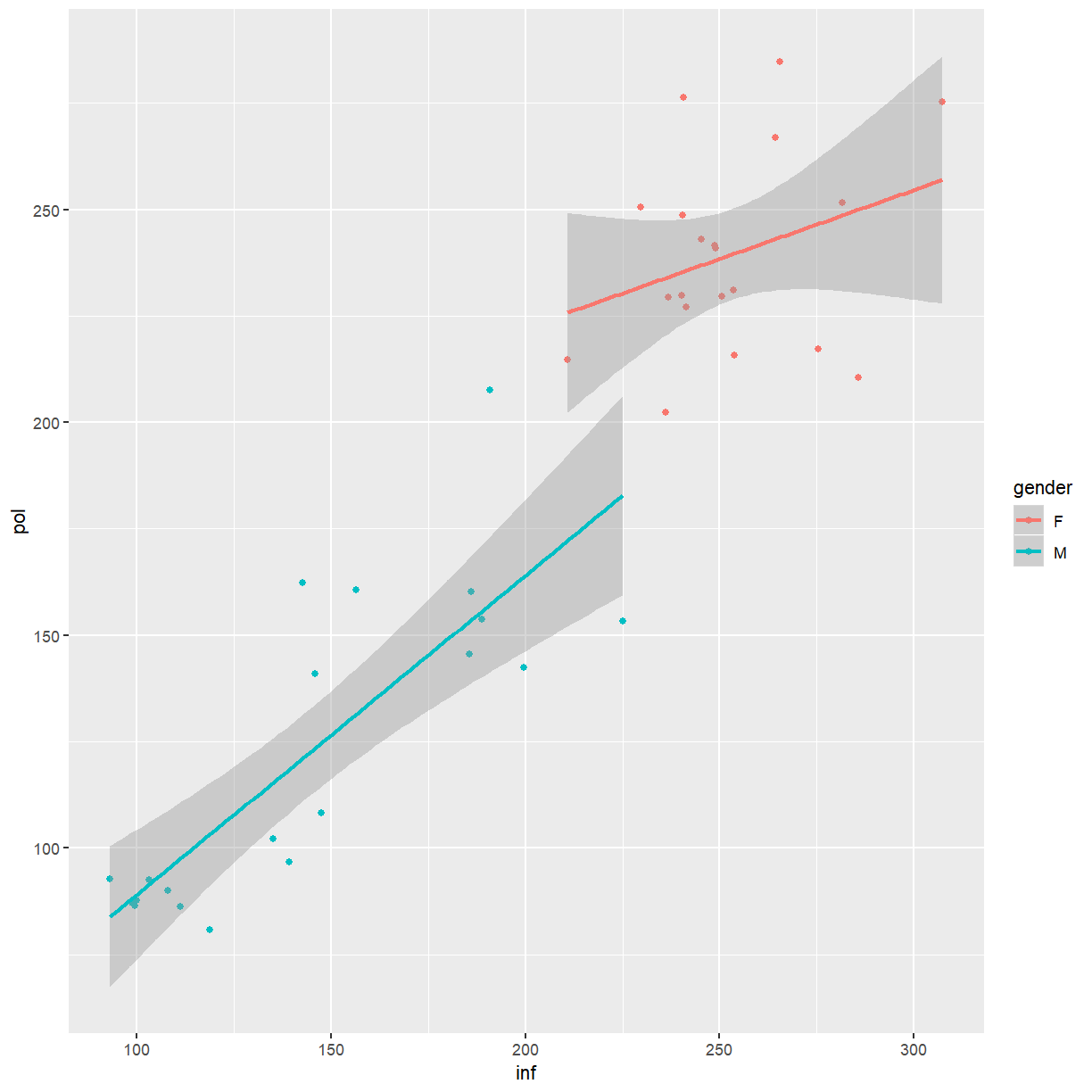
- What do you observe?
As expected, female participants tend to have higher pitched voices than male participants. Considering the slopes of the regression lines in the plot, an interaction between attitude and gender seems plausible and should be investigated.
- Create a plot showing frequency by attitude for each subject.
ggplot(politeness_data, aes(x=attitude, y=frequency, fill=gender)) + geom_boxplot() + facet_wrap(~subject)
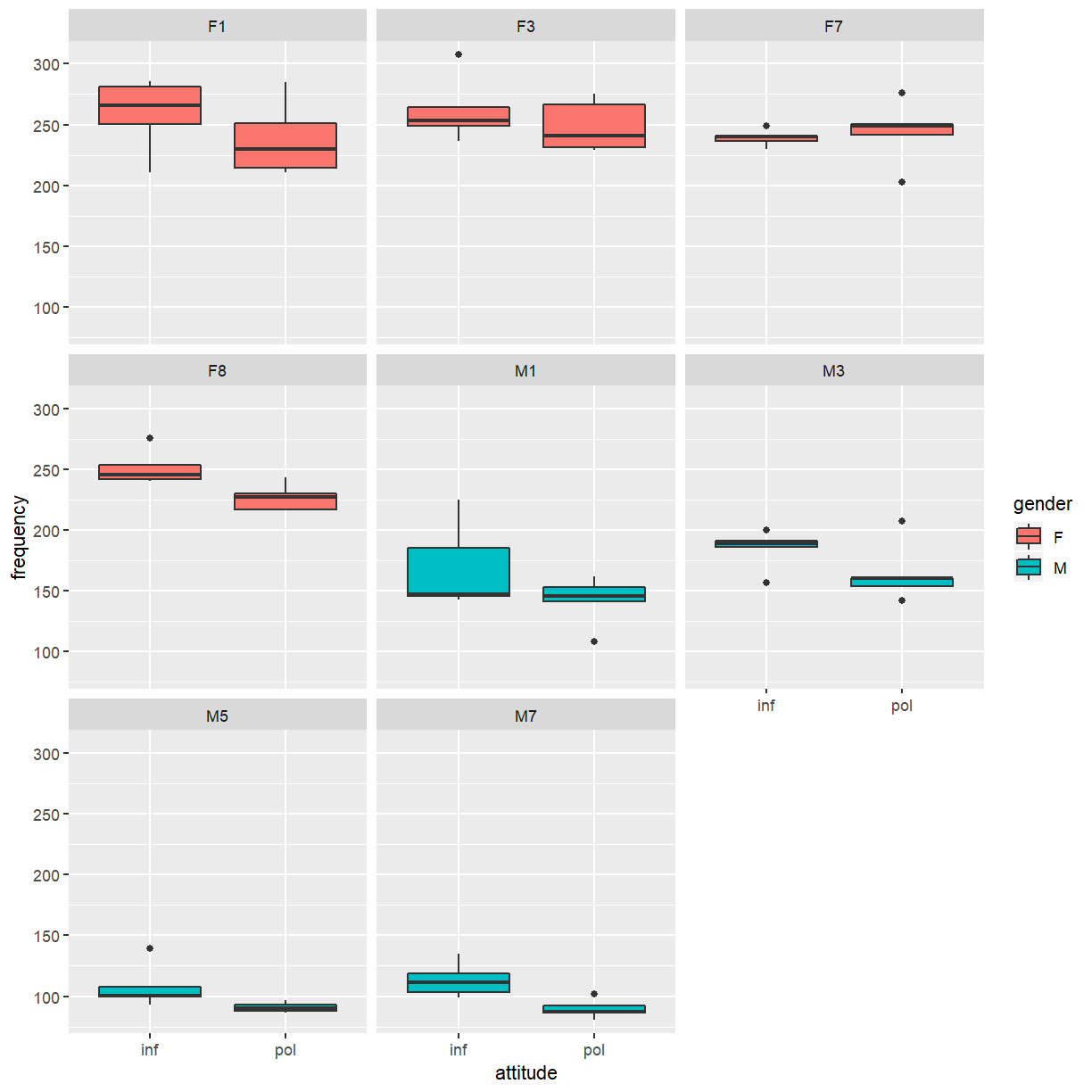
- What trends do you observe in the data?
As expected, the female participants have higher pitched voices and there is considerable variation in pitch between participants. There is also evidence that the samples produced by participants in the polite condition tend to have lower pitch compared to the informal samples from the same participant.
Multiple linear regression
- Fit a multiple linear regression model to the data, using
frequencyas dependent variable andattitudeandgenderas independent variables. Based on the plots of the data above, does it seem necessary to include an interaction between attitude and gender?
The scatter plot suggests that the effects of attitude for male and female participants may differ somewhat, suggesting that an interaction should be considered.
fit_lm <- lm(frequency ~ attitude*gender, data=politeness_data)
- Why is this model likely to be inappropriate?
Since each subject gave multiple responses (a repeated measures design) this model is inappropriate because the multiple responses made by one subject are not independent from each other. For example, every person has a slightly different pitch (frequency) which is a factor that affects all responses from the same subject so these responses will be correlated within the subject.
- Examine the model fit using a Q-Q plot and a residual plot.
qqnorm(rstandard(fit_lm))
qqline(rstandard(fit_lm), col=2)
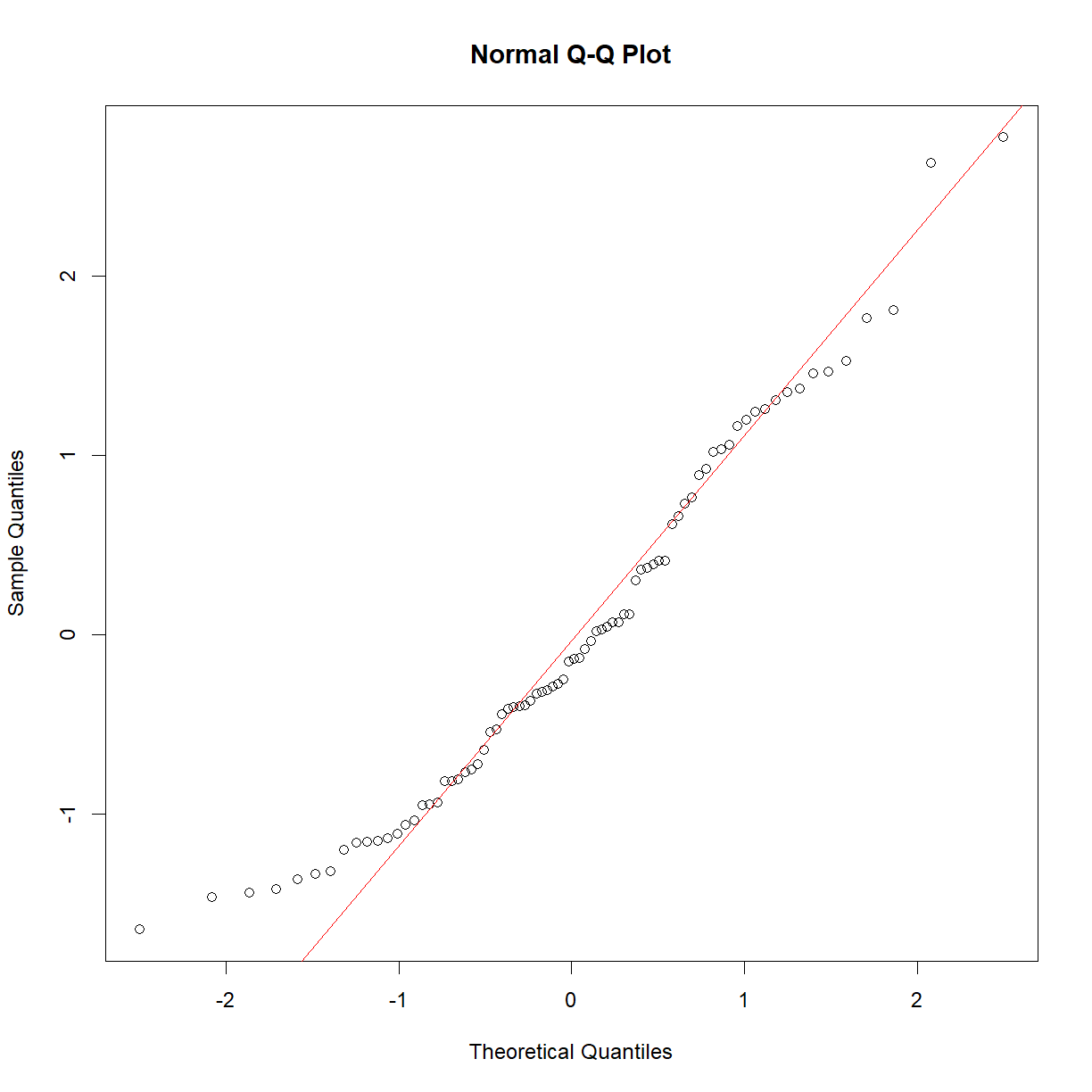
The Q-Q plot shows that the distribution of residuals is skewed slightly to the right, with fewer residuals than expected in the left tail and one or two unexpectedly large residuals in the right tail.
- Create a plot of residuals and fitted values. Distinguish between the two attitudes and between subjects.
politeness_lm_fit <- politeness_data %>% mutate(residuals=rstandard(fit_lm), fitted=fitted(fit_lm))
ggplot(politeness_lm_fit, aes(x=fitted, y=residuals, shape=attitude, colour=subject)) + geom_point(size=2)
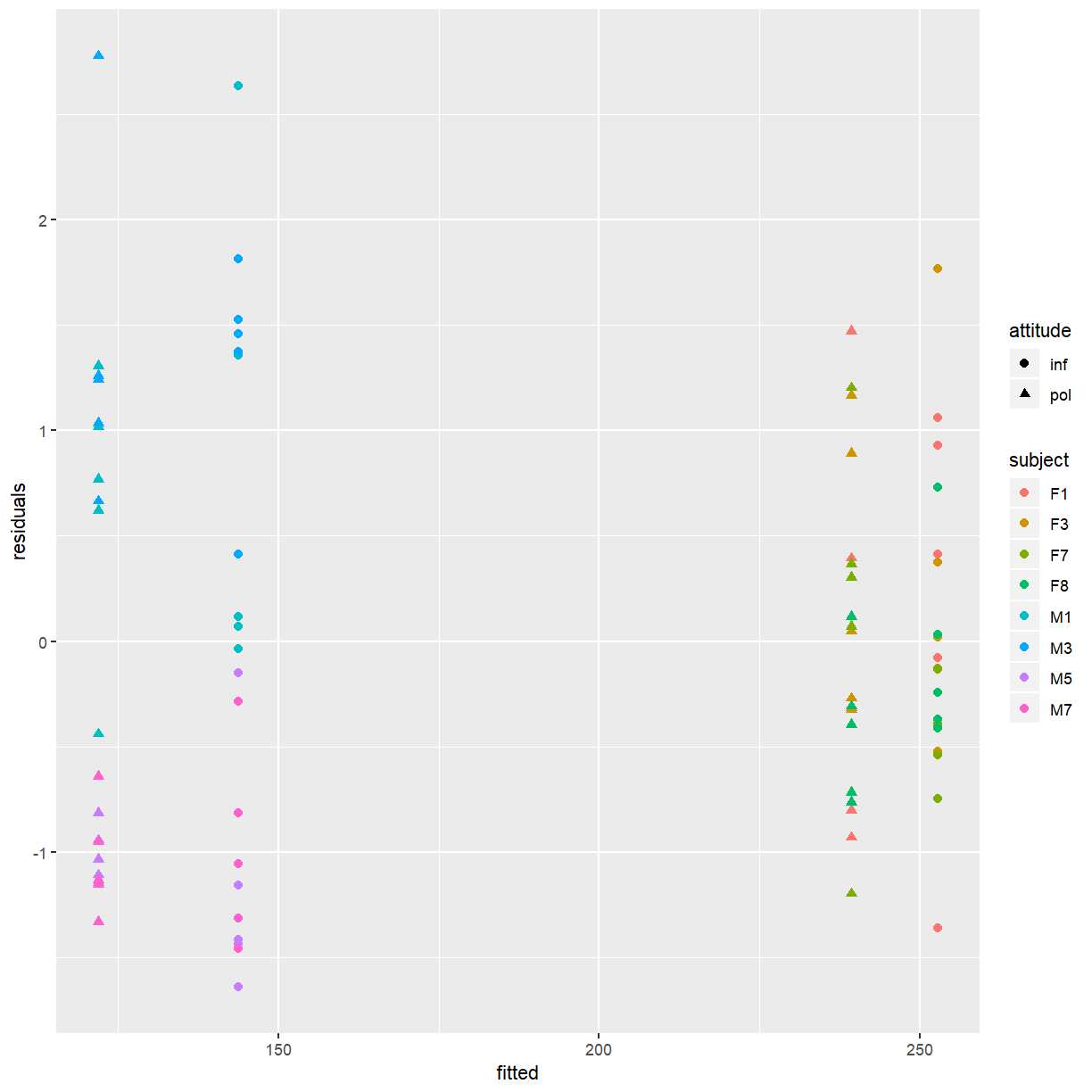
Note how the residuals for the same subject tend to cluster together. This is especially pronounced for the males.
- Use a linear mixed effects model to account for the clustering of the data. In the height example, we used a Family random effect to model the structure of the data. Here a subject random effect seems appropriate.
fit_me <- lmer(frequency ~ attitude*gender + (1|subject), data=politeness_data)
- Use the
ranova()function to check whether the subject random effect is justified.
ranova(fit_me)
ANOVA-like table for random-effects: Single term deletions
Model:
frequency ~ attitude + gender + (1 | subject) + attitude:gender
npar logLik AIC LRT Df Pr(>Chisq)
<none> 6 -353.55 719.10
(1 | subject) 5 -376.34 762.69 45.589 1 1.459e-11 ***
---
Signif. codes: 0 '***' 0.001 '**' 0.01 '*' 0.05 '.' 0.1 ' ' 1
- Create diagnostic plots to examine the model fit.
dotplot(ranef(fit_me))
$subject

qqmath(ranef(fit_me))
$subject
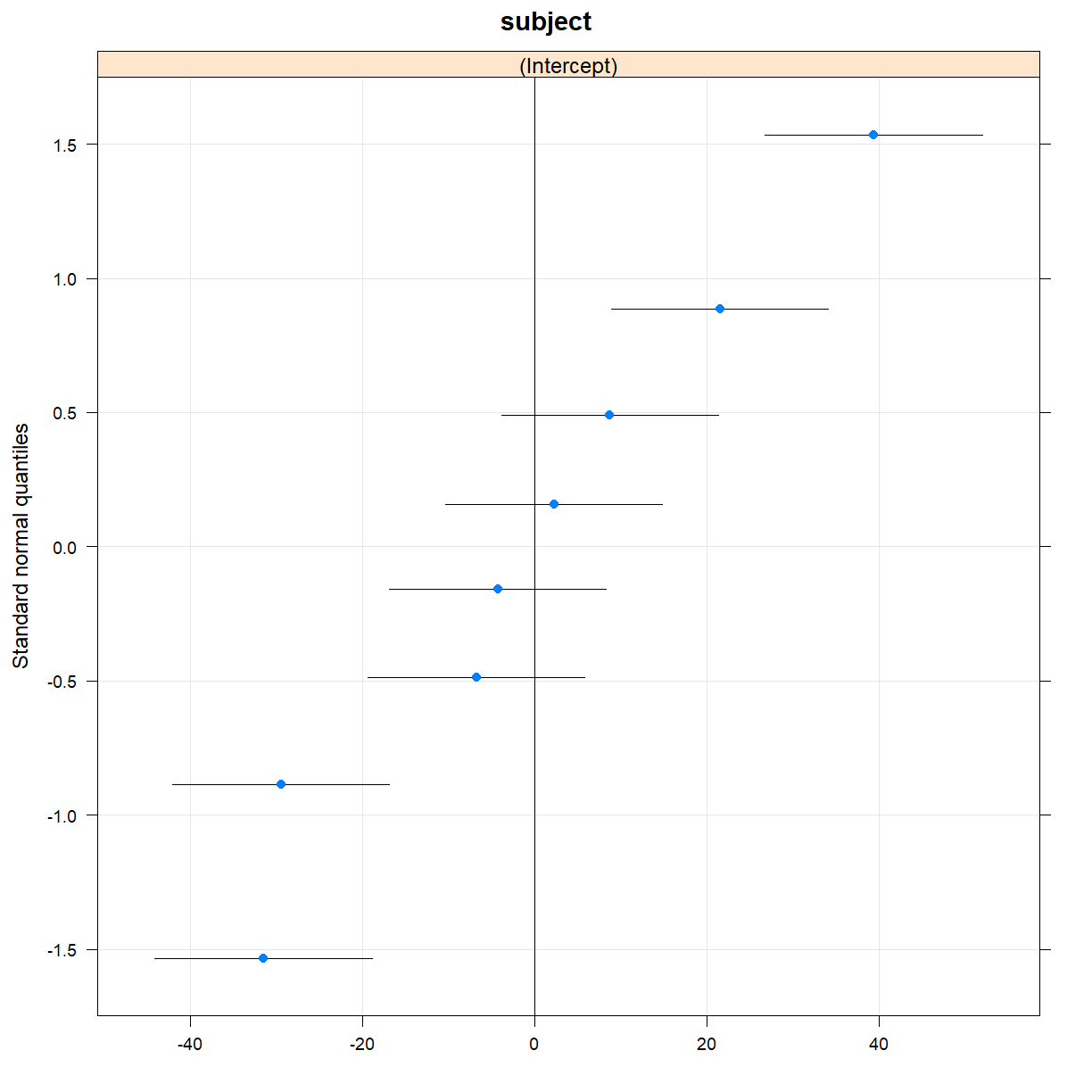
plot(fit_me)
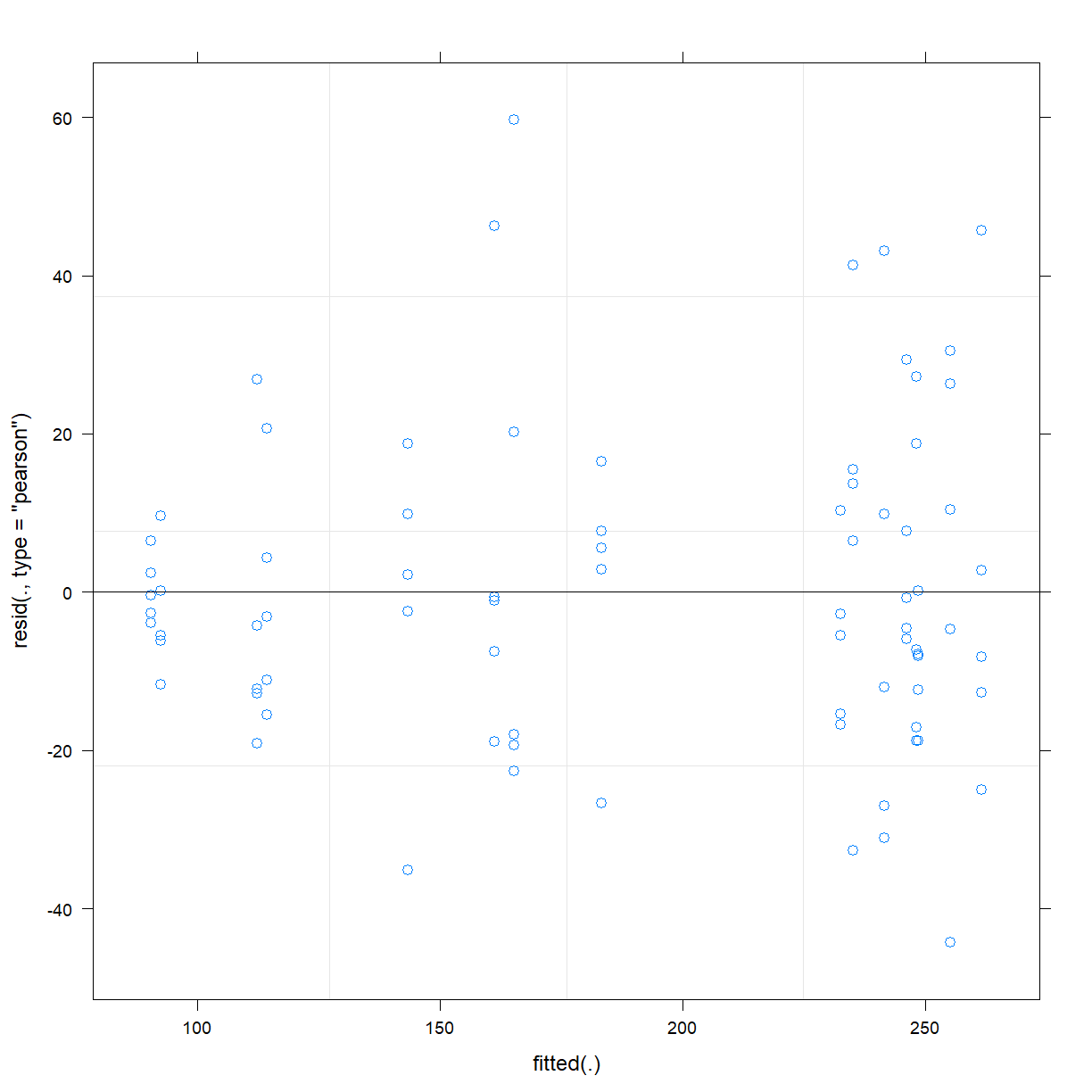
- Take a look at the model summary.
summary(fit_me)
Linear mixed model fit by REML. t-tests use Satterthwaite's method [
lmerModLmerTest]
Formula: frequency ~ attitude * gender + (1 | subject)
Data: politeness_data
REML criterion at convergence: 707.1
Scaled residuals:
Min 1Q Median 3Q Max
-2.1121 -0.5958 -0.1297 0.4716 2.8488
Random effects:
Groups Name Variance Std.Dev.
subject (Intercept) 711.7 26.68
Residual 438.6 20.94
Number of obs: 80, groups: subject, 8
Fixed effects:
Estimate Std. Error df t value Pr(>|t|)
(Intercept) 252.860 14.137 6.715 17.886 6.48e-07 ***
attitudepol -13.530 6.623 70.000 -2.043 0.04483 *
genderM -109.075 19.993 6.715 -5.456 0.00109 **
attitudepol:genderM -8.375 9.366 70.000 -0.894 0.37430
---
Signif. codes: 0 '***' 0.001 '**' 0.01 '*' 0.05 '.' 0.1 ' ' 1
Correlation of Fixed Effects:
(Intr) atttdp gendrM
attitudepol -0.234
genderM -0.707 0.166
atttdpl:gnM 0.166 -0.707 -0.234
- How do the estimates for the fixed effects from this model compare to the estimates from the multiple regression model?
The estimates themselves are the same but the standard errors (and as a consequence of that, the p-values) have changed. The estimate for the effect of politeness (the within subject effect) has a much lower standard error in the mixed effects model but the standard error for gender (the between subject effect) has increased.
- In addition to repeated measures from each subject the data also contain multiple observations for each scenario. This may create another layer of clustering, separately from the one based on subjects. Try adding a second random effect to the model.
fit_me2 <- lmer(frequency ~ attitude*gender + (1|subject) + (1|scenario), data=politeness_data)
summary(fit_me2)
Linear mixed model fit by REML. t-tests use Satterthwaite's method [
lmerModLmerTest]
Formula: frequency ~ attitude * gender + (1 | subject) + (1 | scenario)
Data: politeness_data
REML criterion at convergence: 697.1
Scaled residuals:
Min 1Q Median 3Q Max
-1.9900 -0.5817 -0.1213 0.4320 2.8881
Random effects:
Groups Name Variance Std.Dev.
subject (Intercept) 721.2 26.86
scenario (Intercept) 104.1 10.20
Residual 343.5 18.53
Number of obs: 80, groups: subject, 8; scenario, 5
Fixed effects:
Estimate Std. Error df t value Pr(>|t|)
(Intercept) 252.860 14.775 7.805 17.114 1.81e-07 ***
attitudepol -13.530 5.861 66.001 -2.308 0.02412 *
genderM -109.075 19.874 6.556 -5.488 0.00114 **
attitudepol:genderM -8.375 8.289 66.001 -1.010 0.31600
---
Signif. codes: 0 '***' 0.001 '**' 0.01 '*' 0.05 '.' 0.1 ' ' 1
Correlation of Fixed Effects:
(Intr) atttdp gendrM
attitudepol -0.198
genderM -0.673 0.147
atttdpl:gnM 0.140 -0.707 -0.209
ranova(fit_me2)
ANOVA-like table for random-effects: Single term deletions
Model:
frequency ~ attitude + gender + (1 | subject) + (1 | scenario) +
attitude:gender
npar logLik AIC LRT Df Pr(>Chisq)
<none> 7 -348.53 711.06
(1 | subject) 6 -375.67 763.33 54.276 1 1.742e-13 ***
(1 | scenario) 6 -353.55 719.10 10.046 1 0.001527 **
---
Signif. codes: 0 '***' 0.001 '**' 0.01 '*' 0.05 '.' 0.1 ' ' 1